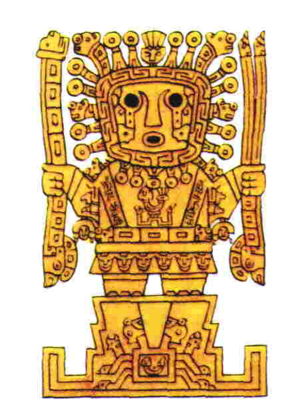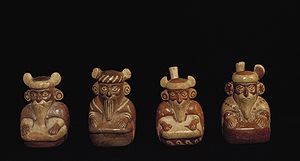- Viracocha
-
This article is about the deity. For the similarly named Eighth Sapa Inca of the Kingdom of Cusco, see Viracocha (Inca). For the Temple of Wiracocha, see Raqchi.
Viracocha is the great creator god in the pre-Inca and Inca mythology in the Andes region of South America. Full name and some spelling alternatives are Apu Qun Tiqsi Wiraqutra and Con-Tici (also spelled Kon-Tiki) Viracocha. Viracocha was one of the most important deities in the Inca pantheon and seen as the creator of all things, or the substance from which all things are created, and intimately associated with the sea.[1] Viracocha created the universe, sun, moon and stars, time (by commanding the sun to move over the sky)[2] and civilization itself. Viracocha was worshipped as god of the sun and of storms. He was represented as wearing the sun for a crown, with thunderbolts in his hands, and tears descending from his eyes as rain.
Contents
Cosmogony according to Spanish accounts
According to the myth recorded by Juan de Betanzos,[3] Viracocha rose from Lake Titicaca (or sometimes the cave of Pacaritambo) during the time of darkness to bring forth light.[4] He made the sun, moon, and the stars. He made mankind by breathing into stones, but his first creation were brainless giants that displeased him. So he destroyed it with a flood and made a new, better one from smaller stones.[5] Viracocha eventually disappeared across the Pacific Ocean (by walking on the water), and never returned. He wandered the earth disguised as a beggar, teaching his new creations the basics of civilization, as well as working numerous miracles. He wept when he saw the plight of the creatures he had created.[citation needed] It was thought that Viracocha would re-appear in times of trouble. Pedro Sarmiento de Gamboa noted that Viracocha was described as "a man of medium height, white and dressed in a white robe like an alb secured round the waist, and that he carried a staff and a book in his hands."[6]
In one legend he had one son, Inti, and two daughters, Mama Quilla and Pachamama. In this legend, he destroyed the people around Lake Titicaca with a Great Flood called Unu Pachakuti, saving two to bring civilization to the rest of the world, these two beings are Manco Cápac, the son of Inti (sometimes taken as the son of Viracocha), which name means "splendid foundation", and Mama Ocllo, which means "mother fertility". These two founded the Inca civilization carrying a golden staff, called ‘tapac-yauri’. In another legend, he fathered the first eight civilized human beings. In some stories, he has a wife called Mama Cocha.
In another legend,[7] Viracocha had two sons, Imahmana Viracocha and Tocapo Virachocha. After the Great Flood and the Creation, Viracocha sent his sons to visit the tribes to the Northeast and Northwest to determine if they still obeyed his commandments. Viracocha himself traveled North. During their journey, Imaymana and Tocapo gave names to all the trees, flowers, fruits and herbs. They also taught the tribes which of these were edible, which had medicinal properties, and which were poisonous. Eventually, Viracocha, Tocapo and Imahmana arrived at Cuzco (in modern day Peru) and the Pacific seacoast where they walked across the water until they disappeared. The word "Viracocha" literally means "Sea Foam."[7]
Etymology
Tiqsi Huiracocha may have several meanings. In the local Quechua language tiqsi means foundation or base, huira (or wira) means fat, and cocha (or qucha[8]) means lake, sea, or reservoir. Viracocha's many epithets include great, all knowing, powerful, etc. Wira-cocha could mean "Fat (or foam) of the sea"[1][9] or "Wise One" or "Creator of all things".[10]
The name is also interpreted as a celebration of body fat (Sea of fat), which has a long pre-Hispanic tradition in the Andes region as it is natural for the peasant rural poor to view fleshiness and excess body fat as the very sign of life, good health, strength and beauty.[11]
Controversy over "White God"
Spanish chroniclers from the 16th century claimed that when the conquistadors led by Francisco Pizarro first encountered the Inca's they were greeted as Gods, "Viracochas", because their lighter skin resembled their God Viracocha.[12] This story was first reported by Pedro Cieza de León (1553) and later by Pedro Sarmiento de Gamboa. Similar accounts by Spanish chroniclers (e.g. Juan de Betanzos) describe Viracocha as a "White God", often with a beard.[13] The whiteness of Viracocha is however not mentioned in the native authentic legends of the Incas and most modern scholars therefore consider the "White God" story to be post-conquest Spanish invention.[14][15]
Similarly to the Incan god Viracocha, the Aztec god Quetzalcoatl and several other deities from Central and South American pantheons, Bochica is described in legends as being bearded. The beard, once believed to be a mark of a prehistoric European influence and quickly fueled and embellished by spirits of the colonial era, had its single significance in the continentally insular culture of Mesoamerica. The Anales de Cuauhtitlan is a very important early source which is particularly valuable for having been originally written in Nahuatl. The Anales de Cuauhtitlan describes the attire of Quetzalcoatl at Tula:
“ "Immediately he made him his green mask; he took red color with which he made the lips russet; he took yellow to make the facade; and he made the fangs; continuing, he made his beard of feathers..."[16] ” In this quote the beard is represented as a dressing of feathers, fitting comfortably with academic impressions of Mesoamerican art. While descriptions of Viracocha's physical appearance are open to interpretation, it should be noted that men with beards were frequently depicted by the Peruvian Moche culture in its famous pottery, long before the arrival of the Spanish:
[1] Modern advocates of fringe theories however such as a pre-Columbian European migration to Peru continue to cite these bearded ceramics and Viracocha's beard as being evidence for an early presence of a non-Amerindian race in Peru.[17][18] Although most Indians do not have heavy beards, there are groups who do, such as the Aché of Paraguay who also have light skin but who show no evidence of admixture with Europeans and Africans.[19]
Representation of Viracocha at Ollantaytambo
According to local myth, a representation of Viracocha – ‘The Creator of Civilization’ is shown in the small village of Ollantaytambo, Southern Peru. Ollantaytambo located in the department of Cusco makes up a chain of small villages along the Urubamba Valley or also known as the Sacred Valley of the Incas, was an important stronghold for the Incan Empire. Facing the ancient Inca ruins of Ollantaytambo in the rock face of 'Cerro Pinkuylluna' is the 140 meter high figure of Wiracocha. The angry looking formation of his face is made up of indentations that form the eyes and mouth, whilst a protruding carved rock denotes the nose. Inca ruins built on top of the face are also considered to represent a crown on his head. Artist impressions of the rock face also include a heavy beard and a large sack upon his shoulders.
The face of Viracocha at Ollantaytambo can be captured as noted by Fernando E. Elorrieta Salazar,[20] Wiracocha, the pilgrim preacher of knowledge, the master knower of time, and described as a person with superhuman power, a tall man, with short hair, dressed like a priest or an astronomer with tunic and a bonnet with four pointed corners.
According to travel writer Paul Jones,[21] "This incredible myth of a Viracocha spreads throughout South America and beyond. This ancient mystical God, who by local legend rose from the middle of Lake Titicaca to create mankind was and is still today truly respected. The rock carving at Ollantaytambo is a striking reminder of the spiritual connections the Inca's had with the Andes."
See also
- The Colombian myth of Bochica which has a similar role as creator and civilizer as Viracocha
- Manco Cápac
- Odin
- Staff God
- Tiwanaku
References
- ^ a b Dover, Robert V. H.; Katharine E. Seibold, John Holmes McDowell (1992). Andean cosmologies through time: persistence and emergence. Caribbean and Latin American studies. Indiana University Press. pp. 274. ISBN 0253318157. http://books.google.com/books?id=V9kXAAAAYAAJ. Retrieved 22 November 2009.:56
- ^ Young-Sánchez, Margaret (2009). Tiwanaku: Papers from the 2005 Mayer Center Symposium at the Denver Art Museum. Denver Art Museum. ISBN 0806199725. http://books.google.com/books?id=RonjAAAAMAAJ&q=Wiracocha+created+the+sun,+moon,+stars,+and&dq=Wiracocha+created+the+sun,+moon,+stars,+and. Retrieved 22 November 2009.
- ^ Alan Kolata's Valley of the Spirits: a Journey into the Lost Realm of the Aymara (1996), pages 65-72
- ^ Andrews, Tamra (2000). Dictionary of Nature Myths. Oxford University Press. pp. 216. ISBN 0195136772. http://books.google.com/books?id=7jS65aClvFEC&pg=PA216.
- ^ "Viracocha". Bloomsbury Dictionary of Myth. Bloomsbury Publishing Ltd., London. 1996. http://www.credoreference.com/entry/2121372. Retrieved 2009-02-10.
- ^ Viracocha and the Coming of the Incas from "History of the Incas" by Pedro Sarmiento De Gamboa, translated by Clements Markham, Cambridge: The Hakluyt Society 1907, pp. 28-58.
- ^ a b "Glossary, Inca Gods". First People of America and Canada - Turtle Island. http://www.firstpeople.us/glossary/native-american-gods-south-america-inca.html. Retrieved 2009-02-10.
- ^ Stobart, Henry (2006). Music and the poetics of production in the Bolivian Andes. Ashgate Publishing, Ltd.. pp. 336. ISBN 0754604896. http://books.google.com/books?id=-yZafFnjvJ4C. Retrieved 22 November 2009.:198
- ^ Damian, Carol; Steve Stein, Nicario Jiménez Quispe (2004). Popular art and social change in the retablos of Nicario Jiménez Quispe. Edwin Mellen Press. ISBN 0773462171. http://books.google.com/books?id=U15dAAAAMAAJ. Retrieved 22 November 2009.
- ^ Columbus, Claudette Kemper (1986). Mythological consciousness and the future: José María Arguedas. American University Studies; Series Ii, Romance Languages and Literature, Vol 52. P. Lang. p. 184. ISBN 0820403407. http://books.google.com/books?id=cbsdAQAAIAAJ. Retrieved 22 November 2009.. (The reference quotes another source Henrique Urbano (1981) Wiracocha y Ayar. Heroes y funciones en las sociedades andinas. Cusco. Possible spelling with eihter W or V
- ^ Weismantel, Mary J. (2001). Cholas and pishtacos: stories of race and sex in the Andes. University of Chicago Press. ISBN 0226891542. http://books.google.com/books?id=KjTTEGwxXHMC&pg=PA6&dq=pishtacos#v=snippet&q=pishtaco&f=false.
- ^ Colonial Spanish America: a documentary history, Kenneth R. Mills, Rowman & Littlefield, 1998, p. 39.
- ^ Pre-Columbian America: Myths and Legends, Donald. A. Mackenzie, Senate, 1996, p.268-270
- ^ The Skeptic: encyclopedia of Pseudoscience, "white god legends", Michael Shermer, ABC-CLIO, 2002, p. 578.
- ^ Mills, 1998, p. 40.
- ^ Anales de Cuauhtitlan., 1975, 9.)
- ^ Fingerprints of the Gods, Graham Hancock, Mandarin, 1996, pp.50-51
- ^ In Quest of the Great White Gods, Robert F. Marx, Crown Publishers, 1992 pp. 7-15.
- ^ Hill, Kim; A. Magdalena Hurtado (1996). Aché life history: the ecology and demography of a foraging people. Aldine Transaction. p. 58. ISBN 978-0202020365. http://books.google.ca/books?id=_2ZQUncZuosC&printsec=frontcover#v=onepage&q=light%20skin&f=false. Retrieved 31 May 2011.
- ^ Fernando E. Elorrieta Salazar & Edgar Elorrieta Salazar - Cusco and the Sacred Valley of the Incas (2005), pages 83 ISBN 978-603-45091-1-5
- ^ Jones, Paul J (2009) author and travel writer, Peru Guide (the only), the online guide to Peru.
Categories:- Creator gods
- Creation myths
- Inca gods
- Aymara mythology
- Inca mythology
- Sky and weather gods
- Solar gods
- Primordial teachers
Wikimedia Foundation. 2010.


